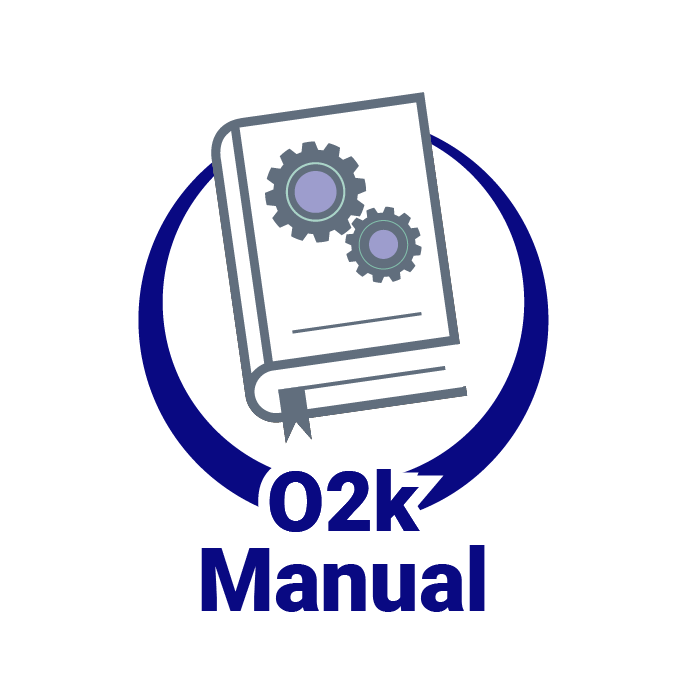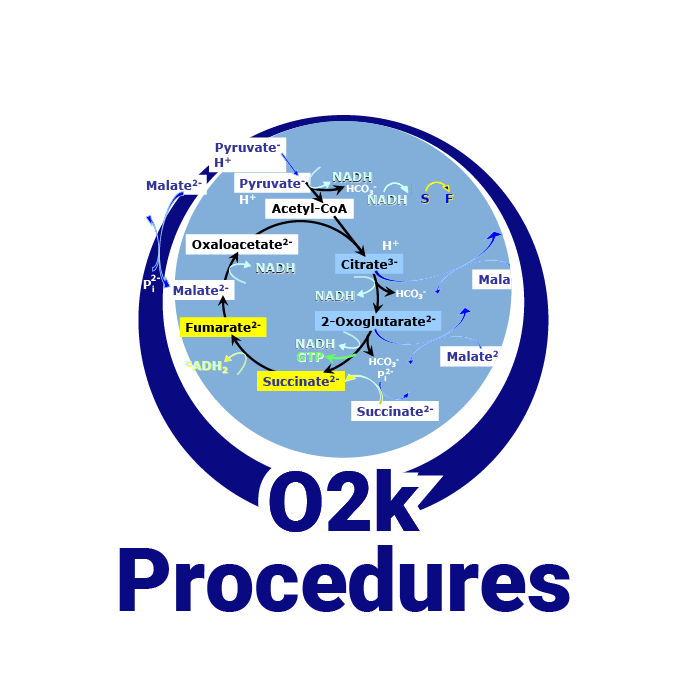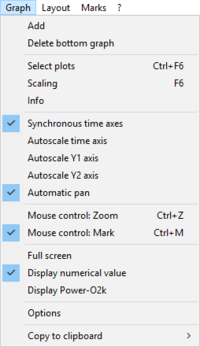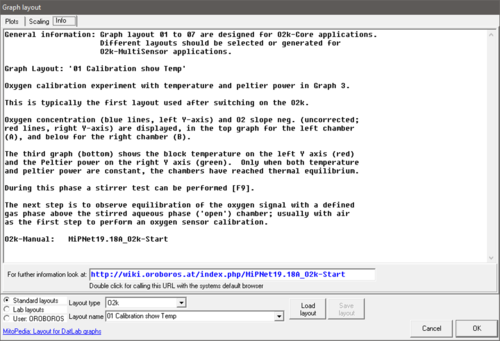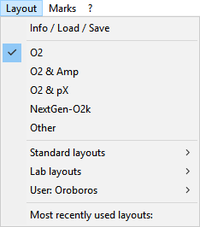From Bioblast
 |
Layout for DatLab graphs |
MitoPedia O2k and high-resolution respirometry:
O2k-Open Support
Description
A Layout in DatLab selected in the Layout menu yields a standardized display of graphs and plots displayed with specific scalings. The graph layout defines initial settings, which can be modified for plots [Ctrl+F6] and scaling [F6]. A modified layout can be saved as user layout without changing the standard layouts.
Graph / Info
- View and edit information, and load or save a graph layout (see below).
- » Quick selection of plots and axes in a graph [Ctrl+F6] and scaling [F6].
Layout: Info/ Load/ Save
- 1. Select one of the layout types available depending on the O2k-configuration:
- O2: Oxygen channel only.
- O2 & Amp: Oxygen and amperometric channel.
- O2 & pX: Oxygen and potentiometric channel.
- Other
- 2. If a different layout type has been selected, open the Layout tab again to select a Standard layout, Lab layout, User layout, or one of the most recently used layouts.
- 1. Select one of the layout types available depending on the O2k-configuration:
Standard layouts - O2k-FluoRespirometer
Version: DatLab 7
- In typical standard DatLab graph layouts plots are shown for the left chamber in Graph 1 (top), and for the right chamber in Graph 2 (below). During data acquisition, a 30 min time range is frequently used and can be adjusted any time during the experiment [F6].
01 Calibration show Temp
- Calibration show temp shows O2 concentration and the negative slope in Graph 1 and 2, and temperature and Peltier power in Graph 3: This is the default layout used after switching on the O2k for performing oxygen calibration.
- Graph 1 & 2: O2 concentration (blue lines, left Y-axis) and O2 slope negative (uncorrected; red lines, right Y-axis) are displayed in the top graph for the left chamber (A), and below for the right chamber (B).
- Graph 3: The third graph (bottom) shows the block temperature on the left Y axis (red) and the Peltier power on the right Y axis (green). Only when both temperature and Peltier power are constant, the chambers have reached thermal equilibrium.
- During this phase a stirrer test can be performed [F9].
- The next step is to observe equilibration of the oxygen signal with a defined gas phase above the stirred aqueous phase ('open') chamber; usually with air as the first step to perform an oxygen sensor calibration.
- Calibration show temp shows O2 concentration and the negative slope in Graph 1 and 2, and temperature and Peltier power in Graph 3: This is the default layout used after switching on the O2k for performing oxygen calibration.
- » Further information: O2 calibration - DatLab
02 Calibration - Background
- Is used for recording O2 sensor calibration and instrumental O2 background test. 'O2 slope neg.' is the negative slope of oxygen concentration, multiplied by 1000 to convert to units [pmol/mL], over time [s]. No correction is applied for instrumental O2 background flux, J°02. 'O2 slope neg.' is plotted on the right Y-axis with a scaling to display ±10 pmol∙s-1∙mL-1 and zero in the middle of the Y2 axis. Zero slope in the 'open' chamber at air calibration indicates the stability of the oxygen signal. After closing the chamber, the slope deviates from zero as a function of the oxygen consumption of the polarographic oxygen sensor and of oxygen diffusion into or out of the chamber, which is the first point in the instrumental O2 background test.
- » Further information: MiPNet14.06 Instrumental O2 background
03 Background high O2
- Is used for recording an instrumental O2 background test at high oxygen from 150 to 450 µM.
04a Flux per volume
- Displays background-corrected oxygen flux per volume, which is most relevant to evaluate experimental details, i.e. flux per volume is optimally in the range of 20 to 200-500 pmol∙s-1∙mL-1. This plot is also chosen when measurements on sample density are available only at a later stage. Total O2 flux is corrected for instrumental O2 background, J°O2,V, to obtain sample oxygen flux per chamber volume, JO2,V:
JO2,V = JO2,V(total) - J°O2,V
04b Flux per volume overlay
- Similar to the layout 04a Flux per volume, Graph 1 shows the background-corrected oxygen flux per volume [pmol∙s-1∙mL-1] superimposed for both chambers. Graph 2 shows oxygen concentration [µM] superimposed for both chambers.
05a Specific flux
- Is used for plotting background-corrected oxygen flux per unit sample. The unit as a marker for the amount of sample is defined in the Sample (F3) window. Example: Select Unit mg for the amount (mass) of sample added to the chamber. The mass-concentration is automatically calculated (division by chamber volume, typically 2 mL). Then mass-specific flux JO2,m [pmol∙s-1∙mg-1] is displayed as volume-specific flux JO2,V [pmol∙s-1∙mL-1] divided by mass-concentration Cm [mg/mL]:
JO2,m = JO2,V / Cm
05b Specific flux overlay
- Is similar to ‘05a Specific flux’. Graph 1 shows the background-corrected oxygen flux per unit sample superimposed from both chambers. Graph 2 shows oxygen concentration [µM].
06a Specific flux high O2
- Is the same as ‘05a Specific flux’ with the scaling adapted to the high oxygen concentration used for permeabilized muscle fibers (150 to 450 µM; range 300 µM).
06b Specific flux high 02 overlay
- As ‘06a Specific flux high O2’, but oxygen flux (Graph 1) and oxygen concentration (Graph 2) superimposed from both chambers.
07a Flux control ratios
- Shows the flux control ratio (FCR) and the oxygen concentration for the left chamber in Graph 1 and for the right chamber in Graph 2. First, the reference and baseline metabolic states are marked and the marks are named (Marks \ Names). Then the marks are selected in the menu Flux / Slope \ A: O2 slope (or B: O2 slope).
07b Flux control ratios overlay
- As ‘07a Flux control ratios’ FCR (graph 1) and oxygen concentrations (graph 2) are superimposed from both chambers.
Lab layouts
User: Name
- A Standard layout or any other layout can be modified and saved under a specific user name, which is recommended to distinguish individual layouts from standard layouts used by a team.
Reference Layouts
Reference Layouts: O2 & Amp
Version: DatLab 7
- 01 Amp Amperometric_Raw signal: A standard layout used for fluorometric or amperometric applications. Graphs 1 and 3 show the O2 concentration (blue line; left axis) and O2 flux per volume (red line; right axis) for chamber A (left) and B (right), respectively. Graphs 2 and 4 show the amperometric or fluorometric raw signal (black line; left axis) expressed as [V] and the amperometric or fluorometric raw slope (green line; right axis) expressed as [mV/s].
- 02 Amp Amperometric_Calibrated: A standard layout used for fluorometric or amperometric applications. Graphs 1 and 3 show the O2 concentration (blue line; left axis) and O2 flux per volume (red line; right axis) for chamber A (left) and B (right), respectively. Graph 2 and 4 show the calibrated amperometric or fluorometric signal (black line; left axis) and the calibrated amperometric or fluorometric slope (green line; right axis). e.g. In the case of Amplex UltraRed assay which is used to detect H2O2 flux, 0.1 µM H2O2 is used to calibrate the signal. In this case the signal is expressed as [µM] and the slope as [pmol∙s-1∙mL-1] after calibration.
Reference Layouts: O2 & pX
Version: DatLab 7
- 01 Potentiometric: A layout used for potentiometric applications. Graphs 1 and 3 show the O2 concentration (blue line; left axis) expressed as µM and O2 flux per volume (red line; right axis) expressed as pmol/(s*mL) for chamber A (left) and B (right), respectively. Graphs 2 and 4 show the potentiometric raw signal (dark blue line; left axis) expressed as [V] between +10 and -10 V and the slope (red line, right axis) calculated from the signal expressed as [mV/s] between +2 and -2.
- 02a TPP_calibration: A layout used for TPP calibration. Graphs 1 and 3 show the O2 concentration (blue line; left axis) expressed as µM and O2 slope negative (red line; right axis) expressed as [pmol∙s-1∙mL-1] for chamber A (left) and chamber B (right), respectively. Graphs 2 and 4 show the potentiometric raw signal (dark blue line; left axis) expressed as [V] during TPP calibration between -3 and -3.5, and the slope calculated from the signal expressed as [mV/s] (red line, right axis) between +0.2 and -0.2.
- 02b TPP_with_O2flux: A layout used for TPP experiments. Graphs 1 and 3 show the O2 concentration (blue line; left axis) expressed as µM and O2 flux per volume (red line; right axis) for chamber A (left) and B (right) expressed as pmol/(s*mL), respectively. Graphs 2 and 4 show the potentiometric raw signal (dark blue line; left axis) expressed as [V] during TPP calibration between -3 and -3.5, and the slope calculated from the signal expressed as [mV/s] (red line, right axis) between +0.2 and -0.2.
- 02c TPP_calibrated_with_O2flux: A layout used for TPP experiments. Graphs 1 and 3 show the O2 concentration (blue line; left axis) expressed as µM and O2 flux per volume (red line; right axis) for chamber A (left) and B (right) expressed as [pmol∙s-1∙mL-1], respectively. Graphs 2 and 4 show the TPP signal (dark blue line; left axis) between -5.8 and -6, and the slope calculated from the signal (red line, right axis) between +0.2 and -0.2.
Reference Layouts: Other
Version: DatLab 7
- O2 raw signal: Graphs 1 and 2 show the O2 raw signal expressed in units volt [V] (blue line; left axis) and the O2 slope negative (red line; right axis) expressed as mV/s for chamber A (left) and chamber B (right). Graph 3 shows the block temperature on the left Y axis (red) and the Peltier power on the right Y axis (green). Only when both temperature and Peltier power are constant, the chambers have reached thermal equilibrium.
MitoPedia O2k and high-resolution respirometry:
DatLab

